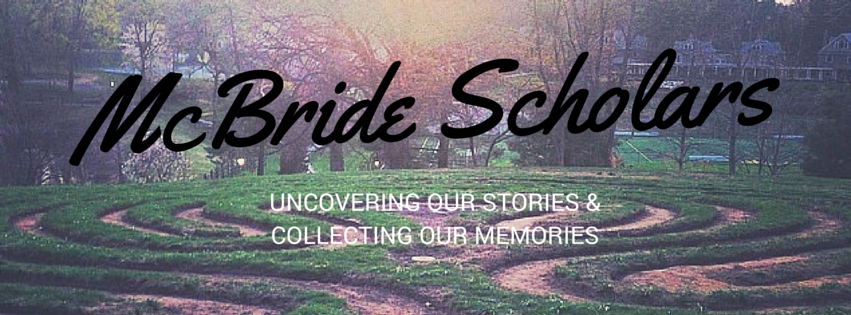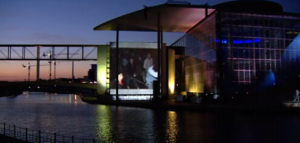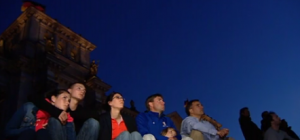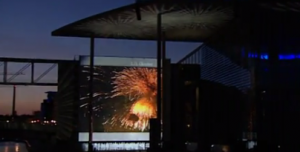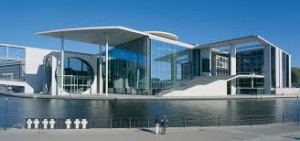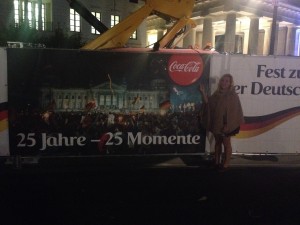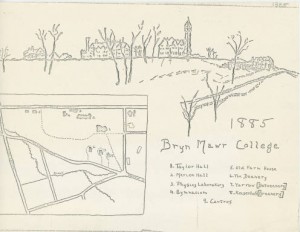Anassa Kata & McBride Proposal
Congrats to all the finishing seniors! I made a digital mockup of the digital portion for my draft and wanted to share it for those who are interested. The proposal blog post doesnt have my whole paper included, just the part that is the active “project” ideas. Keep an eye out for this event (McBride Monologues) and hopefully this blog to keep growing!
Here ya go: https://mcbridecollection.wordpress.com/2016/05/07/collection-project-proposal/
Archiving Madness
I recently had the opportunity to go to “Re(covering) Ourstories,” an event/exhibit/panel on the “bathroom graffiti controversy of 1988” that occurred at Bryn Mawr College. Organized by a Bryn Mawr student, the event examined an incident that happened on campus close to 30 years ago. In 1988, students at Bryn Mawr noticed that their bathrooms had been graffitied with insults and slurs hurled towards minorities on campus, particularly people of color and LGBTQ people. Amidst heightened racial and sexual tensions on campus due to elevated anonymous threats being delivered to students in addition to the recent death of a beloved classmate, a group of BMC students decided that they would reclaim the bathrooms and cover up the harmful graffiti in them with their own positive affirmations for one another. Since the administration had known about the slurs in the bathroom for weeks and had failed to do anything about it, the students (who had confined their activist graffiti to one bathroom) believed that their graffiti would be there for at least a week. However, the administration caught wind of the graffiti almost immediately after it was first put on display and decided that something had to be done to get rid of it, stat. With so many queer-positive expressions and concerns displayed within the graffiti, the administration feared that the public world of Bryn Mawr (which was still trying to figure out how to handle its LGBTQ identity amidst its more conservative alums/history) was colliding with the private world of Bryn Mawr. In haste, the administration decided that the new graffiti needed to be covered, and in a scene that could come out of a dark comedy, the President of the College enlisted the President of SGA to help her paint over the graffiti during the evening. What came next is history.
There are so many components to the bathroom graffiti story that make it a multifaceted and complex subject as a whole in Bryn Mawr’s history. It’s necessary to know the context of LGBTQ identities at the College during the time to understand the admin’s decision, in addition to the climate of the campus in general. I was impressed with the presentation of the exhibit and was glad that photographs of the positive graffiti had been taken before they were painted over. I particularly appreciated the panel that was set up to help get all of the points of view concerning the event on the table. This included one of the people who spray painted the positive graffiti, the then editor of the College News, and the then President of SGA. Without the points of views, the exhibit would’ve still been fascinating but it also would’ve missed a crucial, human element that made the event such a representative part of Bryn Mawr’s history during the time.
This exhibit is a real life example of the importance of documenting and archiving history at Bryn Mawr for the sake of institutional as well as activist memory. I had no idea about the bathroom graffiti incident until I came to the event and it intrigued me how easy it was to cover the event up and let it fade as the turnover of students occurred. This could very well happen with events that have occurred on campus within the last couple of years as well. The only thing that might prevent this, is the active presence of the Internet and social media to keep reminding and informing new people when others have forgotten. However, even the Internet is fallible, and things can be deleted from there too. Which makes the case that archiving, at the moment, from multiple perspectives/points of views is not only important but crucial to maintaining memory, and by attachment, history.
Rugby, Women’s Athleticism, and Institutionalization at Bryn Mawr
I am using my thesis on the Horned Toads, the Bryn Mawr-Haverford women’s rugby team, as a starting point for this project. For my thesis, I have interviewed 16 current and former Horned Toads players about their experiences, had informal conversations with the current athletics director and head athletic trainer about their experiences working with the team, and researched the team’s history in the Bryn Mawr College archives. However, at the end of the day, all of this research putting together a history that isn’t comprehensively documented anywhere else isn’t going to be seen by many people–just me, my advisor and second reader, and whoever I choose to send it to. I think, though, that the history of the Horned Toads is a relevant history for Bryn Mawr College to grapple with publicly. Even though most students don’t play on the Horned Toads, the team has been prominent in Bryn Mawr culture throughout most of its history (arguably up until about the time any of us started at Bryn Mawr), to the point where one of my interviewees from the late 2000s said that Bryn Mawr during her time there had three social institutions: Radnor, the Pems, and rugby. Additionally, thinking about the history of the Horned Toads as a case study is a valuable way to interrogate larger questions that I think are relevant for Bryn Mawr’s campus history. First, I think it’s important to think about the role of athletics at our DIII women’s college, where athletics often receive little attention. What can be gained from centering an often-silenced part of Bryn Mawr’s history? Additionally, what does looking at the history of rugby at Bryn Mawr illuminate about larger ideas about women and sports? Second, I think that looking at the history of the rugby team is a valuable way to get at questions of the tensions between what I’ve begun to term student agency and administrative oversight. The Horned Toads’ history, as I find in my thesis research, has been defined by two main trends–desiring and actively working for greater institutionalization into the athletics department, and resisting restrictions put upon the team by the athletics department. What can understanding the history of the Horned Toads in this way illuminate about larger patterns of student-administrator interaction at Bryn Mawr, and how student agency is promoted and/ or limited in other spaces?
I see Erin Bernard’s history truck as a model for this project. I want this public history project about the Horned Toads to be truly created by community members, not just available for them to see. I would want to invite all members of the Bryn Mawr community to participate in oral history interviews and contribute artifacts related to the team–this way, I hope to put together a picture of the Horned Toads’ history that isn’t just from team members’ perspectives, but explores how the team has interacted with all aspects of Bryn Mawr life. I also want to think through the potential of objects (Schiavo) and places (Hayden) as ways of exploring the Horned Toads’ changing institutionalization. In some ways, it’s possible to represent the team’s history through spaces and objects they gain access to or lose. Prior to the 2000s, the team practiced on Haverford’s dedicated rugby field, but then Haverford decided that they needed the field for something else and took it away–now the team practices on the field behind the Graduate School of Social Work, which they have to share with local kids’ football teams. When the Horned Toads became more institutionalized into the Bryn Mawr athletics department in the mid-2000s, they gained access to spaces they hadn’t been able to utilize before, such as the trainer’s room. This institutionalization also brought access to objects that signify athletic status on Bryn Mawr’s campus–the green Gatorade water bottle and athletics t-shirts–and gained the team access to the athletics banquet where, like the varsity athletes, they are given gifts to commemorate their athletic involvement. However, access to these objects and spaces normally afforded only to varsity athletes doesn’t signify complete institutionalization for the Horned Toads (they are still not a varsity team and don’t have access to all athletics resources), so I’m interested in exploring the potentials and limitations of objects and places as representations of social changes.
For my image for this post, I chose a picture of a comic about the rugby team printed in the September 1987 issue of the College News (less than a year after the team’s founding). The comic prompted the entire team to write a letter to the editor, published in the next issue of the College News, simultaneously objecting to the team being portrayed as all about drinking and defending their right to drink after a game and still be considered athletes. Tensions over alcohol consumption as part of athletic practice have been central to the Horned Toads’ relationship with the athletics department, and also get at larger questions about the role of alcohol and sport in constructing hegemonic masculinity. I see this comic as simultaneously representative of student perceptions of the Horned Toads and the Horned Toads’ struggle for institutionalization over its 30 year history.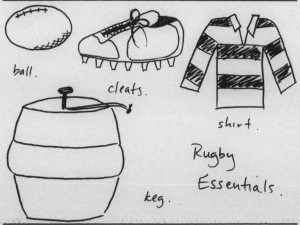
d to the p: space & affect & *the college news*
My project is inspired by a lot of the work that I do with *the college news* and I hope to use the issue of the current office space in the Pagoda to understand the history and presence of the newspaper and other “extra-curricular” student services at Bryn Mawr. I’m envisioning that my project will have a few different legs: 1) the history of *the college news*, 2) the newspaper’s online presence, 3) the physical space of the Pagoda and the editor’s interactions with administrators to hold onto that space. I’m hoping that the project will help think through saving, the issue of being semi-private and semi-public in our publication, and the power of narratives and story-telling for the teller and the community.
I started to think about this in terms of space because the college news has been having a hard time getting a permanent space on campus that can be our office. I know that other colleges have permanent rooms for their newspaper staff, so it seems odd to me that it’s so difficult to make that happen here. It makes me think that if it takes so much for a school newspaper—which plays such an important role in marketing the campus and capturing what kind of community we are—to get an office, that something about the foundations of the school doesn’t care about student spaces and student life.
Further, thinking about space is important because I’ve been wondering about how spaces structure affect, which I saw us discuss a lot in this class. I see my project in conversation with Erika Doss’s project Memorial Mania: Public Feeling in America. Doss sees an obsession with memorializing, and thinks about how memorials structure public feeling, and functions as a focal point of community building. I see *the college news*, particularly because it is a feminist newspaper and so connected to lived experience, as similar to memorials.
I’ve also been thinking about the online presence of *the college news* in terms of Take Back the Archive. When I was on the train once working on “the secrets issue,” the man across from me asked what I was working on, and when I told him he asked where he could find my article. I told him: nowhere. As far as the outside world is concerned, *the college news* doesn’t really exist. This is good in some ways–we can tailor our content, we don’t need to explain or define certain terms or traditions for the most part, and when students write very personal things relating to gender or sexuality or trauma, we can offer them a certain degree of protection. However, I wonder if we’re limiting our potential for connecting with others outside our community or our ability to save content. It seems to me that Purdom Linblad is grappling with a similar problem, and her approach has been similar to ours: move slowly.
As I said, my project has a few different legs, but my hope is that thinking about *the college news* will help Bryn Mawr students and community members think about the semi-open and semi-private nature of the college itself. In the few years I’ve been here, I’ve seen Bryn Mawr students struggle to identify with other undergraduates at peer institutions. I’ve been in rooms with people who see strong similarities between our experiences at Bryn Mawr and other students, but Bryn Mawr seems to be cloistered in multiple ways. We aren’t on the national stage in the same way that other Seven Sisters are, and I wonder to what extent the architecture of the college and its mission are in relationship with that separation. I see the newspaper as an example or case study of this tension.
Chose Your Own (History) Adventure: A Day in the Life of (You)
My idea for the campus history project centers around making the campus history accessible to everyone and also forcing us to reflect upon how we use our spaces currently. I propose to make the entire campus an exhibit. Instead of having an exhibit in the library that nobody will visit, I want the exhibit to be available to students, faculty, staff, and other community members as they go about their daily lives. That means that means that there will not be any special access to spaces allowed during the exhibit. For example, dorms will not be open for faculty members, and students who don’t usually go to the back of the dining hall kitchens will not be allowed there. This exhibit is meant to be for the people who already inhabit these spaces. This means that community members must evaluate why they or others do or do not have access to certain spaces, and what that means for the community. For example, what does it mean that there are certain spaces that are not accessible to students in wheelchairs? Exhibits that are not in accessible locations will be marked as such.
As for what will be included in the exhibit, I want to have profiles of 10 or so community members, past or present. Each profile will follow where the community member spent their time, with objects and writings. People participating in the exhibit will have the option of following one profile at a time, of course only accessing spaces they already have access to, or choosing their own path. It would hopefully be engaging to choose your own path, or just go about your day normally, and see what histories you encounter.
I do not have anyone specific in mind, and I don’t think this exhibit needs to be about anyone who made extraordinary accomplishments. I believe that everyone has a story that is interesting enough to be told, and so we do not need to focus on who was the first or who did it best. I think that brings two benefits. The first being that we will be able to hear stories that we don’t normally hear about. The second being that I’m hoping this exhibit will inspire students and other community members to donate their belongings, whatever is wanted, to Special Collections. By seeing the exhibit of normal yet extraordinary people, others will hopefully think that they too can donate what they have, because they are also important. This exhibit is for, first and foremost, for community members. For them to learn a bit of their past, and the history of the institution, but also to feel empowered to contribute to that history themselves. And for them to know that they are already contributing to that history, but just need to document it!
McBride Scholars: Collecting Our Stories, Filling the Gaps
For my final project I would like to propose a creation plan digital archival repository for the McBride Scholars of Bryn Mawr College’s history. I intend use a combination of class readings, academic writings about the lives of nontraditional students, and the small amount of publically available information on the McBride program. I believe that the unique dynamics of the McBride community have extensively contributed to Bryn Mawr’s history. However, in my preliminary research I have found very little information available. I will draw connections between this void and the spaces public historians have problematized during this semester. With this proposal, I believe that this is an archival silence that can be solved.
This project was primarily inspired by our work on the Summer School for Workers and the digital exhibits “The Summer School for Women Workers: Diversity, Class and Education” and “BRYN MAWR COLLEGE: A WORK IN PROGRESS”. These exhibits both explore the lives of marginalized students who were also “non-traditional”. Both of these exhibits do not mention the McBride Program, I want to explore why that is a recurring narrative in Bryn Mawr’s public history. I believe that the reasons for the founding of the Summer School resonate with the McBride program’s current cohort. The reasons for the founding of the McBride program are unclear and I think that defining this is essential to contextualizing Bryn Mawr’s history and public narrative.
I intend to answer many of the questions that have been plaguing me since I first discovered the invisibility of McBrides in our shared public history at BMC. I want to explore why we don’t appear in any of the archival or special collections repositories available online. I would like to create a more concrete timeline of the McBride’s history. I would like to outline a plan for collecting oral histories to learn about place and body memory experiences McBrides have had on campus. I will use digital tools such as the wayback machine archive to determine what organizational documents and publications are in need of collection. I will also propose the collection of photographs and physical objects (like May Day gifts). The program has undergone many changes over it’s 30 year history but there has been a constant theme of resilience that is important to make a part of the public conversation.
Living in History at Bryn Mawr
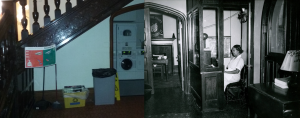
Under the Pem West Staircase: 2016 vs. the 1950s/60s. A receptionist once used the “bells desk” on the right to admit visitors to the dorm, or to inform students that a guest had arrived.
Before consulting Tripod in order to write my survey reflection, I hadn’t realized just how many places on campus have been completely changed or repurposed over the years. At some point in Bryn Mawr’s history, for example, the dining hall in Rockefeller became an architecture studio, and a soda machine now stands where a receptionist used to sit in Pembroke West (see above). We see and interact with these spaces every day as students, just as students before us had done for over a century. However, I at least was never fully aware of how the dorms functioned differently for past students, especially since traces of this history seem to have been removed as the spaces were updated.
My proposal had originally centered on the recreation of old dorm rooms using the furniture items stored in Special Collections, many of which resemble those seen in photos from the early 1900s. This could still be plausible on a smaller scale, but there are other historic spaces that cannot be easily reconstructed, such as the bells desk mentioned above. In these areas (as well as in the recreated rooms), photographs would be displayed in a sort of visual timeline, showing how the function of the space changed with the passing decades. Many photos on Tripod depict students and housekeepers living and working in the dorms, and would thus add a personal dimension to the history of each space. The dorm room exhibits would be set up during the school year on occupied halls, so that students in neighboring rooms could interact directly with the history of the building in which they were living. By situating displays and photographic timelines around campus, I would hope to make the history of these spaces more visible, fostering a connection between those who once lived in them and those who live in them today.
Constructing a Public Historical Narrative
Rather than creating a Bryn Mawr public history project, I am looking to an existing history project in Berlin.
“Vom Reichstag zum Bundestag”
Constructing a Public Historical Narrative for Reunified Germany
Looking to theories of film, history, spectacle, and architectural design, I hope to examine the space for film consumption in Berlin’s new government district as part of the political rhetoric of democracy as the inherently superior form of governing put forth by the German government. Berlin is a city rich with monuments—old and new— often ones that are mostly abstract and relying heavily on the power of metaphor. The buildings across the river from the Reichstag are prime examples of this type of new monument. Though these buildings are new, they serve similar functions as their older counterparts. Both old and new monuments for government districts use the power of spectacle to enhance a sense of national pride and unity. Government monuments also serve to root themselves within certain historical narratives.
The film and light show in Berlin’s government district functions to support a type of national pride and tell the correct version of German political history. This particular film focuses on the history of the Reichstag building from the late 19th century to today. The show uses old strategies of spectacle and collective-making and new technologies of film, light displays, and sound on modern architecture to give it a fresh feel and distance itself from historical uses of the same space in Berlin.
There are two main components that I would like to study: (1) the permanent aspects of the constructed space (the memorial, the buildings, and the steps) and (2) the temporary ones (light and film projections).
More info on the projections and the buildings:
Since 2012, from the end of June until the celebrations on German Unity Day on October 3rd there is a light show and film projected onto the Marie-Elisabeth Lüders House in Berlin along the Spree River tracing the story of the Reichstag building from the late 19th century to today. The film projected is titled “Dem deutschen Volke — Eine parlamentarische Spurensuche. Vom Reichstag zum Bundestag,” which can be translated as “For the German people – Tracing the Parliament. From Reichstag to Bundestag.” The film is created by the government and is in German with English and German subtitles, indicating that the film is also for a non-German speaking, probably tourist audience.
The Marie-Elisabeth-Lüders House, completed in 2003, with the Federal Chancellory and Paul-Löbe-House form part of “Federal Row” designed as an architectural symbol of German unity. A bridge across the Spree connects the Marie-Elisabeth-Lüders House and Paul-Löbe-House, each on either side of the former wall, symbolizing the connection between East and West Berlin and also connecting the past to the present with the naming of the buildings. Below the Lüders House there is a memorial to the Berlin Wall.
Here is a Map of Government District to get a better sense of the space.
Handheld Campus History
For my final project, I am examining history tour apps and proposing one for Bryn Mawr. This semester I have been fascinated with discussions we have had about expanding the narratives of spaces, layered histories, and alternate history exhibitions. I see a thoughtfully designed history app as a potential way to represent contrasting and often conflicting histories about spaces.
I think a tour app hypothetically can interact with a wider variety of campus visitors than traditional tours. I am aiming to design something that a casual visitor, a dog walking local, students, and others with varying degrees of interest in Bryn Mawr’s history can all use.
I originally thought about modeling my tour app on SPARK’s Movement’s “Women on the Map” project which uses Google Maps to alert users “when they are near places where women made history.”
After meeting with Monica, and as a result looking at few other projects such as the “Histories of the National Mall,” the StoryCorp app, and Harvard’s campus tour app, my proposed app has morphed. Now I want to include elements from all of the aforementioned projects to create something that will suit Bryn Mawr, allow for a plurality of stories and experiences to be told while being more accessible to users. I plan to examine and evaluate the projects Monica suggested along with the Philadelphia Maps and Walks app to see what works and what doesn’t.





